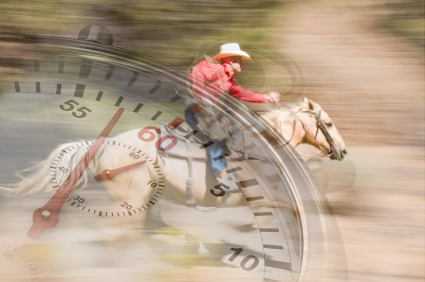
You
probably do not recognize the names of businessmen William Russell, Alexander
Majors and William Waddell but you have heard of their solution to a common
business problem: speed of delivery. The three men were part of a logistics
company, moving equipment and supplies between Kansas City and Santa Fe by
wagon in the 1850s. Among their customers was the U.S. Army. In fact, their
company set a record for a round trip delivery between the two cities - 92
days! Can you imagine waiting that long on a package to get to you?
Russell,
Majors and Waddell realized that if they could shorten the time it took to make
a delivery, they could gain huge government contracts. They devised a plan to
do just that. They set up 150 posts, approximately 12 miles apart, between
Missouri and California. At each post they set up a livery for horses and a
boarding house for a rider to get food and a good night's sleep. 4,000 riders
were hired to carry a 20 lb pack and race across the west, changing out horses
at each post and handing off their pack every 75-100 miles. On their initial
run, they delivered a package between Sacramento, California and St. Joseph,
Missouri in only ten days, eclipsing the speed of any competing delivery service.
Russell, Majors and Waddell called their new logistics company the Central
Overland California and Pikes Peak Express Company. The general public called
it the Pony Express.
The time it
takes to deliver a product or service is often identified as a key performance
indicator, along with quality and cost, which leads to customer satisfaction.
Quality, cost and delivery have been expressed as the QCD analysis. They are
the three primary areas that customers use to judge your business and its
products. The components of QCD have a unique relationship to each other. You
typically need two of the three to be able to market them well. For instance,
any time you can shorten the time it takes to do a business task without
compromising the quality, it is a grand opportunity for marketing. Likewise, if
you have great quality and a low cost, you can find someone who will be
forgiving if it takes a little longer to deliver than normal. They can be
placated by the thought that quality at a great price takes a little longer.
However, if you have fast service, but you deliver junk at a high price, no one
will buy from you. They also will not purchase your inexpensive, poor quality
products that take forever to deliver.
The Pony
Express was a great idea. Russell, Majors and Waddell solved a delivery
problem. However, within a year and a half the Pony Express went out of
business. Why? For one, they were terribly expensive, even by today's
standards. Packages were charged $5 per half ounce! That is $160 per pound! Did
the overall quality of the service expand over delivery by wagon or seafaring
vessel? No, in fact there were size and weight restrictions on your package
that did not exist in the other delivery methods. It had to fit into a
saddlebag and weigh under 20 lbs. Many have blamed the technologically advanced
telegraph and intercontinental railway system for the demise of the Pony
Express. In reality, the Pony Express never became solvent before these factors
came into play. Russel, Majors and Waddell only had the D of the equation, and
it just was not enough to make a successful marketing pitch.
What was
true in the middle of the 19th century is still true today. The
marketing of time will give you an edge over your competition only if you can
couple it with either great quality or low cost. If you gain all three, you
have reached marketing heaven. Corner the market while you can.
________________________
Apr 3, 1860: Pony Express
debuts, This Day in History, www.history.com
Original photos by Lynette Smith and Sergey Ilin